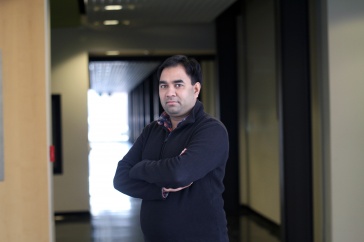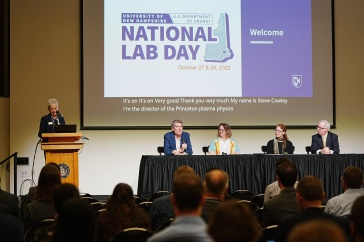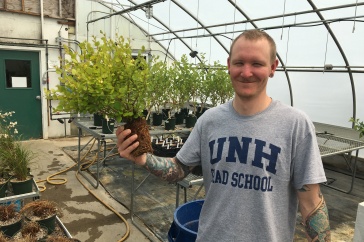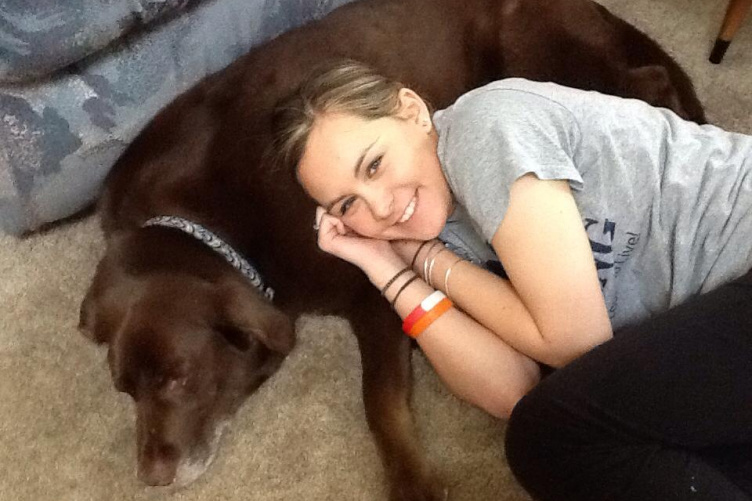
Allison Onofrio '16 is seen in this courtesy photo with her dog, Hershey, one of the inspirations behind her research project.
We dog lovers are likely to talk about how our canine buddies can sense changes in tone of voice and moods and — of course — how they are highly attuned to the smell, sight and sound of the treat bag. But what many of us may not know is our furry friends are also sensitive to the Earth’s magnetic field.
This sensitivity was unveiled in a 2013 Frontiers in Zoology study, and now one UNH senior is working to build on those results. In the 2013 study, scientists found that dogs have a preferred axis for, yes, when they need to “go,” and now Allison Onofrio ’16 is investigating whether the Earth’s magnetic field also affects how dogs lie down.
“My research stems from a study that shows dogs defecate on a North/South (N/S) axis,” explains Onofrio, a neuroscience and behavior major who is traveling to homes all over New England studying dog behavior for her research project, which she will present at the 17th Annual Undergraduate Research Conference (URC) this month.
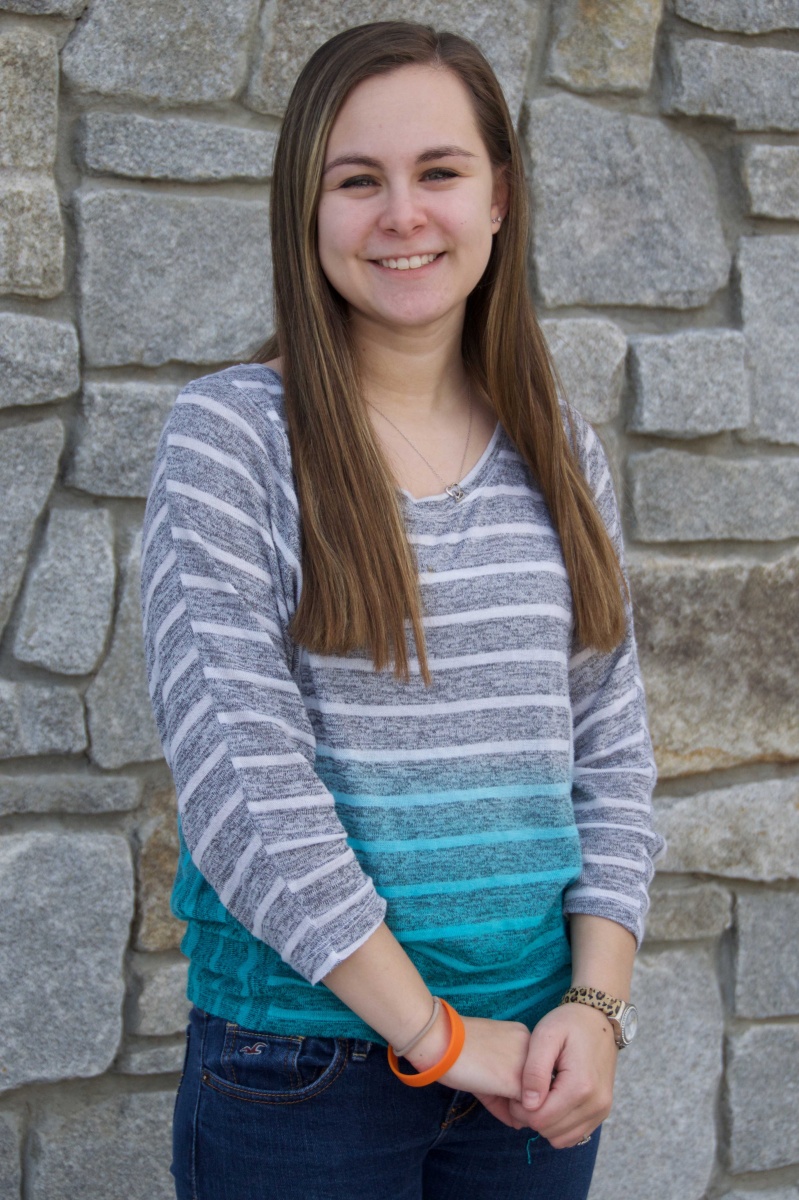
When Onofrio talks about her study with friends and family, they’re quick to respond, “Of course you’re doing research about dogs,” she says, smiling as she calls up her notes on her computer. Her laptop’s background photo features a beautiful chocolate Labrador retriever with a graying muzzle and soulful eyes.
“That’s Hershey,” Onofrio explains. “She’s the reason I do what I do.”
From the time Onofrio was 7 until Hershey’s passing in the summer of 2014, Hershey was her devoted companion. She inspired Onofrio’s college essay and solidified her love of animals, which in turn led Onofrio to her current research, her recent internship at the Massachusetts Society for the Prevention of Cruelty to Animals and her hope to forge a career in animal behavior.
Last semester, in Leslie Curren’s animal behavior class, Onofrio first learned about the 2013 study. She worked on a group project to expand the premise by researching how dogs lie down when not commanded to do so.
“The study of the Earth's magnetic field affecting a dog's behavior is a relatively new field. Therefore, I wondered if this would extend to other behaviors dogs exhibit,” she explains.
"Allison came up with this project idea herself and was the driving force behind putting it into action,” Curren adds, explaining how “Allison took it and elevated it to the next level this spring.”
Onofrio and her classmates had studied a relatively small sample of dogs, so she decided to embark on an independent study this term with Curren as her advisor to build upon that research.
“Professor Curren has been fantastic. I was so lucky,” Onofrio says. “When I switched into neuroscience, I got a recommendation to see her, and she’s been the perfect person.”
This semester, Onofrio increased the number of dogs involved in her study and the number of trials she would record for each individual dog.
“This study has two hypotheses, the first being that dogs will universally lie down on a N/S axis, based on the Frontiers in Zoology study. The second hypothesis is that dogs will have an individual preference to which axis they lie down on and will consistently lie down on that axis over time,” she explains, citing a 2007 study that showed such a preference in another member of the animal kingdom: the newt.
During her research, Onofrio has to be careful to ensure the dogs can choose how to lie down without human factors influencing their decisions. For example, she points out, she can’t simply command a dog to lie down, because the position in which such a command is given can influence the dog’s response.
“Other factors that influence the way they lie down are lying against — and sometimes on — furniture, a wall, a person or another animal,” she explains.
She can spend hours at a residence waiting for a dog to become comfortable enough to remain lying down so she can take a reading. Conversely, at one home with multiple dogs, the pets were quite cooperative in repeatedly getting up and lying down on their own, allowing her to tally data on four dogs in about an hour and a half.
Onofrio’s research includes 20 slots for each dog. Once the dog lies down, she places her compass at the thoracic spine to measure the coordinates out of 360 degrees and determine whether the dog is positioned on the north-south, east-west, northeast-southwest or southeast-northwest axis.
“My study is important to the science community because it adds to the knowledge we have of the evolution of the Earth's magnetic field usage in animals,” she explains. “Also, it is important to learn more about dogs and their behavior because they are animals with which we spend so much time.”
So far, Onofrio says, the results are very interesting: “Early indications suggest each dog has its own individual preferential axis.”
Hear Allison present her research.
The Parents Association Undergraduate Research Symposium takes place Friday, April 22, at the MUB, and the COLSA Undergraduate Research Conference takes place Saturday, April 23, also at the MUB.
However, Onofrio points out that her study is ongoing — and will be even after she presents her latest findings at the URC. From learning she loved research last semester to preparing to present at both the COLSA and Parents Association portions of the URC, Onofrio will next take her research to another level. She has received the Charles H. Turner Award to attend this year’s Animal Behavior Society conference. She plans to continue her research this summer and present even more detailed data.
Onofrio says Curren’s recommendation that she apply for the fellowship award and her professor's support of her efforts are one example of how helpful and encouraging the UNH faculty has been.
“She is a driven and ambitious student, and it has been a real pleasure working with her,” Curren says. “I'm looking forward to seeing her present her work to the COLSA community.”
Looking to the future, Onofrio is excited about what her research might reveal.
“The fact that this is a new field is very exciting,” she says. “We’re just at the tip of the iceberg of what we know about everything. With research and technology, new discoveries are being made every day.”
The Undergraduate Research Conference is underway. Find an event near you.
-
Written By:
Jennifer Saunders | Communications and Public Affairs | jennifer.saunders@unh.edu | 603-862-3585

















































